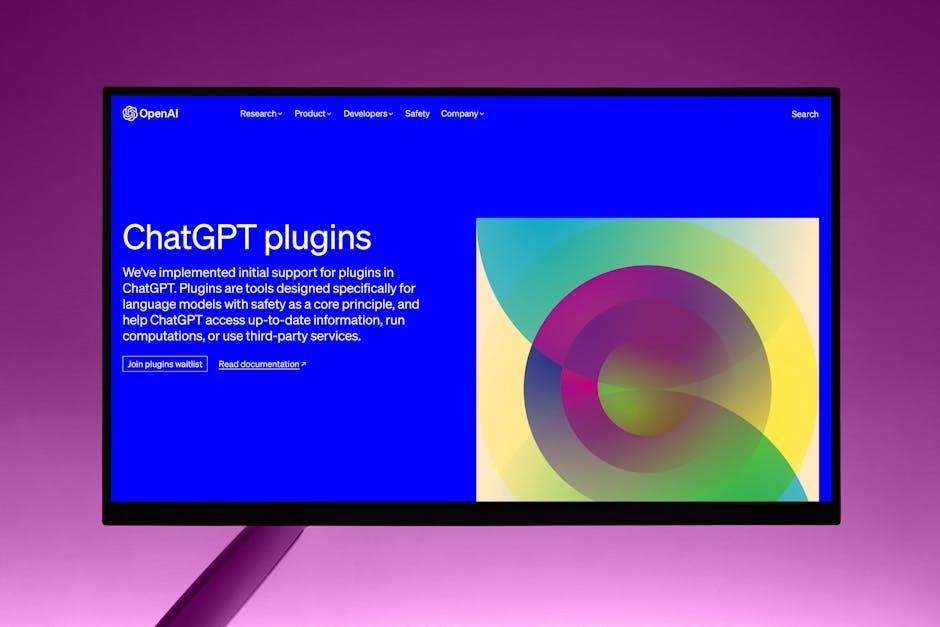The Agile Manifesto, created in 2001 by 17 software developers, revolutionized the industry by emphasizing flexibility and collaboration. It’s available as a downloadable PDF guide.
1.1 Historical Background and Creation
The Agile Manifesto was created in 2001 by 17 software developers who met at Snowbird, Utah. They aimed to address the inefficiencies of traditional development methods. The document emerged from a collaborative effort, influenced by methodologies like Extreme Programming and Scrum. It marked a pivotal shift toward iterative, customer-centric approaches. The manifesto’s creation was a response to the rigid processes dominating the industry at the time, laying the foundation for modern agile practices.
1.2 Purpose and Significance in Software Development
The Agile Manifesto aimed to transform traditional software development by prioritizing collaboration, customer interaction, and adaptability. Its purpose was to create a framework that values individuals, working software, and continuous improvement. This shift from rigid processes to flexible, iterative approaches significantly enhanced productivity and customer satisfaction. The manifesto’s principles have become foundational, influencing methodologies like Scrum and Kanban, and are widely adopted across industries for their emphasis on delivering value and responding to change effectively.

Core Values of the Agile Manifesto
The Agile Manifesto outlines four core values: individuals and interactions, working software, customer collaboration, and responding to change. These principles guide teams toward collaboration, delivery, and adaptability.
2.1 Individuals and Interactions
The Agile Manifesto prioritizes individuals and interactions over processes and tools. This value emphasizes collaboration, communication, and teamwork, recognizing that people are the heart of successful projects. By fostering open dialogue and trust, teams can adapt quickly and deliver solutions aligned with customer needs. Valuing individuals ensures creativity, innovation, and shared responsibility, making it a cornerstone of Agile methodology.
2.2 Working Software
The Agile Manifesto emphasizes that working software is the primary measure of progress. This value underscores the importance of delivering functional increments regularly, ensuring that the software meets customer needs and expectations. By prioritizing working software, teams focus on tangible outcomes, fostering trust and collaboration. It aligns with Agile’s iterative approach, where frequent deliveries of valuable software are central to achieving project success and satisfying stakeholders.
2.3 Customer Collaboration
Customer collaboration is a cornerstone of the Agile Manifesto, prioritizing direct engagement over contract negotiations. This value ensures that developers and customers work together closely, fostering mutual understanding and alignment. By involving customers throughout the development process, Agile teams can deliver solutions that truly meet their needs. This collaborative approach builds trust, reduces misunderstandings, and ensures that the final product aligns with customer expectations, ultimately driving satisfaction and success.
2.4 Responding to Change

Agile emphasizes embracing change as a natural part of the development process. The manifesto highlights that responding to change is more valuable than following a rigid plan. Agile teams are structured to adapt quickly to new requirements, even late in the project, ensuring deliverables remain relevant. This flexibility allows businesses to leverage change for competitive advantage, delivering working software that meets evolving customer needs efficiently and effectively. It contrasts sharply with traditional methods that resist changes once plans are set.

The Twelve Principles of Agile Software Development
These principles guide Agile methodologies, emphasizing frequent delivery of working software, customer collaboration, and welcoming changing requirements. They prioritize technical excellence and maintainable code, ensuring sustainable development.
3.1 Our Highest Priority is to Satisfy the Customer
Delivering valuable software that meets customer needs is the top priority. Agile emphasizes frequent delivery of working solutions, welcoming changing requirements, and continuous collaboration with stakeholders to ensure satisfaction. By focusing on customer-centric outcomes, teams adapt quickly to feedback, fostering trust and long-term partnerships. This principle underscores the importance of aligning development efforts with business goals and user expectations, ensuring sustainable and successful outcomes.
3.2 Welcome Changing Requirements
Agile processes embrace change, even late in development, to deliver customer satisfaction. This principle encourages flexibility, allowing teams to adapt to new requirements and market demands. By welcoming changes, Agile ensures that the final product aligns with evolving customer needs, providing a competitive advantage. This approach fosters collaboration and continuous improvement, ensuring that software remains relevant and valuable throughout its lifecycle.
3.3 Deliver Working Software Frequently
Delivering working software in short intervals, from weeks to months, ensures progress and customer satisfaction. This principle emphasizes iterative development, where functional increments are released regularly. It allows stakeholders to provide feedback early, enabling teams to make necessary adjustments promptly. Frequent delivery also promotes transparency, builds trust, and ensures that the software meets user needs effectively, aligning with Agile’s focus on continuous improvement and value delivery.
3.4 Business People and Developers Must Work Together
Collaboration between business stakeholders and developers is essential for aligning software development with business goals. Daily interactions ensure mutual understanding, enabling teams to deliver value effectively. This partnership fosters trust, reduces miscommunication, and allows for timely adjustments based on feedback. By working together, both parties ensure that the software meets customer needs and stays aligned with business objectives, enhancing overall project success and satisfaction.
3.4.1 Daily Collaboration
Daily collaboration between business people and developers ensures alignment and mutual understanding. Regular interactions help clarify requirements, address issues promptly, and adapt to changes. This continuous dialogue fosters trust, reduces misunderstandings, and ensures that the software aligns with business objectives. By involving stakeholders daily, teams can deliver incremental value, enhancing customer satisfaction and project success. This practice is a cornerstone of Agile, promoting transparency and shared accountability.
3.4.2 Shared Understanding
Shared understanding ensures that all team members and stakeholders have a common vision and goals. This is achieved through continuous communication and collaboration, fostering clarity and alignment. By maintaining a shared understanding, teams can avoid misunderstandings and misalignment, ensuring that the software developed meets the intended objectives. It promotes effective teamwork and better alignment between business needs and technical delivery, enhancing overall project success and customer satisfaction.

Agile Methodologies and Frameworks
Agile methodologies like Scrum, Kanban, XP, and Lean emphasize collaboration, iterative delivery, and adaptability. These frameworks guide teams in implementing Agile principles effectively and efficiently.
4.1 Scrum
Scrum is a widely adopted Agile framework emphasizing teamwork, accountability, and iterative progress. It structures work into sprints, typically 2-4 weeks, with defined roles: Scrum Master, Product Owner, and Development Team. Daily Stand-ups and Sprint Retrospectives foster collaboration and improvement. Scrum aligns with the Agile Manifesto by focusing on delivering working software and responding to change, ensuring transparency and customer satisfaction throughout the development process.
4.2 Kanban
Kanban is a visual, pull-based Agile method emphasizing continuous delivery and limiting work in progress. It uses a board to track tasks, fostering transparency and flow. Unlike Scrum, Kanban doesn’t use sprints; instead, it focuses on continuous improvement and adaptive planning. By aligning with the Agile Manifesto, Kanban prioritizes delivering working software and responding to change, promoting efficiency and reducing cycle times for teams seeking flexibility and sustained productivity.
4.3 Extreme Programming (XP)
Extreme Programming (XP) is an Agile methodology emphasizing technical practices like test-driven development, pair programming, and continuous integration. It aligns with the Agile Manifesto by prioritizing working software and customer collaboration. XP encourages frequent deliveries of high-quality software, ensuring customer satisfaction through rapid feedback and iterative improvements. Its focus on technical excellence and responsiveness to change makes it a popular choice for teams aiming to deliver reliable and adaptable solutions.
4.4 Lean Software Development
Lean Software Development is an Agile methodology focused on eliminating waste and optimizing resources. Inspired by the Toyota Production System, it emphasizes continuous improvement and delivering value quickly. By prioritizing efficient workflows and minimizing non-value-adding activities, Lean ensures high-quality software delivery. It aligns with the Agile Manifesto by focusing on customer satisfaction and responding to change through iterative, effective improvements and rapid feedback.

Challenges and Criticisms of the Agile Manifesto
Agile has faced criticism for being misinterpreted, leading to inconsistent implementation. Some argue it lacks structure, making it less effective in highly regulated or complex environments.
5.1 Misinterpretation and Misapplication
The Agile Manifesto is often misinterpreted, leading to its misapplication in software development. Many teams overlook the original values, prioritizing speed over sustainability or collaboration. This results in practices like neglecting documentation or ignoring metrics, which can undermine project success. Additionally, the lack of clear structure in Agile can lead to confusion, especially in large or complex projects, where adherence to the manifesto’s principles becomes challenging without proper guidance or experience.
5.2 Lack of Structure in Certain Contexts
The Agile Manifesto’s flexibility can sometimes lead to a lack of structure, particularly in complex or large-scale projects. Without clear guidelines, teams may struggle with accountability and consistency. This can result in missed deadlines or poor-quality deliverables. While Agile thrives in dynamic environments, it may require additional frameworks or practices to ensure stability in contexts where rigid processes are essential, balancing flexibility with necessary structure for success.

Printable Agile Manifesto PDF
The printable Agile Manifesto PDF is a concise guide that includes the original manifesto and its marketing version, offering teams a handy resource for Agile principles.
6.1 Availability and Uses
The Agile Manifesto PDF is widely available for download, offering a compact guide to the core values and principles. It is accessible in multiple formats, including A4 and letter sizes, making it easy to print and share. Teams often use it as a quick reference or training tool to align on Agile practices. The PDF includes both the original manifesto and its marketing version, providing versatile guidance for different contexts. Its portability ensures it can be used in meetings, workshops, or as a daily reminder of Agile principles.
6.2 Agile Marketing Version
The Agile Marketing Version adapts the original manifesto’s principles for marketing teams, emphasizing collaboration, flexibility, and delivering value. It aligns marketing strategies with Agile methodologies, fostering adaptability and customer-centric approaches. The PDF includes this version, providing marketers with a clear framework to integrate Agile practices. It encourages iterative processes, real-time feedback, and responsive strategies, ensuring marketing efforts remain aligned with business goals and customer needs.
The Agile Manifesto has transformed software development, emphasizing collaboration, adaptability, and delivering value. Its principles remain timeless, guiding teams to embrace change and prioritize customer satisfaction effectively.
7.1 The Future of Agile Software Development
The future of Agile software development lies in its adaptability and evolution. As technology advances, Agile methodologies will integrate with AI, automation, and remote collaboration tools. The core values of the manifesto—customer satisfaction, iterative delivery, and team empowerment—will remain central; Organizations will embrace hybrid models, blending Agile with other frameworks to enhance flexibility. The focus will shift to scaling Agile principles across enterprises, ensuring sustainable growth and continuous improvement in delivering high-value software solutions.
